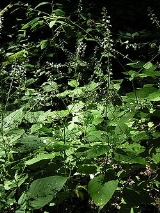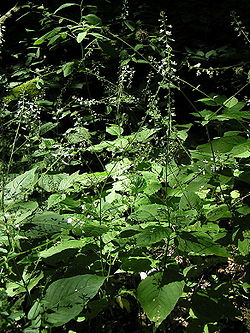
Circaea lutetiana
Encyclopedia
Circaea lutetiana is a plant
in the evening primrose family, Onagraceae
.
The genus name comes from the enchantress Circe
of Greek mythology and the generic designation is derived from Lutetia, the Latin name for Paris. Paris at one time was known as the "Witch City". Despite its name it is not especially toxic, but contains a lot of the astringent
tannin
.
 Circaea lutetiana is a perennial herbaceous plant
Circaea lutetiana is a perennial herbaceous plant
with opposite, simple leaves
, on slender, green stems. The flowers are white, borne in summer. It grows 20 cm to 60 cm, rarely up to 75 centimeters high.
The leaves are rounded or slightly notched at the base, they narrow gradually to the pointed tip and are not strongly toothed, but have sinuate edges. The leaf stalks are equally hairy all round.
The flower has 2 notched petals, 2 stamens and a 2-lobed stigma. The open flowers are well spaced along the stalk and there are no bracts at base of individual flower stalks. The fruit consists of 2 equal cells, and usually sets seed. The flower stalks become angled downwards before fruiting.
In winter the aerial parts die off leaving an underground rhizome
.
Plant
Plants are living organisms belonging to the kingdom Plantae. Precise definitions of the kingdom vary, but as the term is used here, plants include familiar organisms such as trees, flowers, herbs, bushes, grasses, vines, ferns, mosses, and green algae. The group is also called green plants or...
in the evening primrose family, Onagraceae
Onagraceae
Onagraceae, also known as the Willowherb family or Evening Primrose family, are a family of flowering plants. The family includes about 640-650 species of herbs, shrubs, and trees in 20-24 genera...
.
The genus name comes from the enchantress Circe
Circe
In Greek mythology, Circe is a minor goddess of magic , described in Homer's Odyssey as "The loveliest of all immortals", living on the island of Aeaea, famous for her part in the adventures of Odysseus.By most accounts, Circe was the daughter of Helios, the god of the sun, and Perse, an Oceanid...
of Greek mythology and the generic designation is derived from Lutetia, the Latin name for Paris. Paris at one time was known as the "Witch City". Despite its name it is not especially toxic, but contains a lot of the astringent
Astringent
An astringent substance is a chemical compound that tends to shrink or constrict body tissues, usually locally after topical medicinal application. The word "astringent" derives from Latin adstringere, meaning "to bind fast"...
tannin
Tannin
A tannin is an astringent, bitter plant polyphenolic compound that binds to and precipitates proteins and various other organic compounds including amino acids and alkaloids.The term tannin refers to the use of...
.
Description

Herbaceous plant
A herbaceous plant is a plant that has leaves and stems that die down at the end of the growing season to the soil level. They have no persistent woody stem above ground...
with opposite, simple leaves
Leaf
A leaf is an organ of a vascular plant, as defined in botanical terms, and in particular in plant morphology. Foliage is a mass noun that refers to leaves as a feature of plants....
, on slender, green stems. The flowers are white, borne in summer. It grows 20 cm to 60 cm, rarely up to 75 centimeters high.
The leaves are rounded or slightly notched at the base, they narrow gradually to the pointed tip and are not strongly toothed, but have sinuate edges. The leaf stalks are equally hairy all round.
The flower has 2 notched petals, 2 stamens and a 2-lobed stigma. The open flowers are well spaced along the stalk and there are no bracts at base of individual flower stalks. The fruit consists of 2 equal cells, and usually sets seed. The flower stalks become angled downwards before fruiting.
In winter the aerial parts die off leaving an underground rhizome
Rhizome
In botany and dendrology, a rhizome is a characteristically horizontal stem of a plant that is usually found underground, often sending out roots and shoots from its nodes...
.

